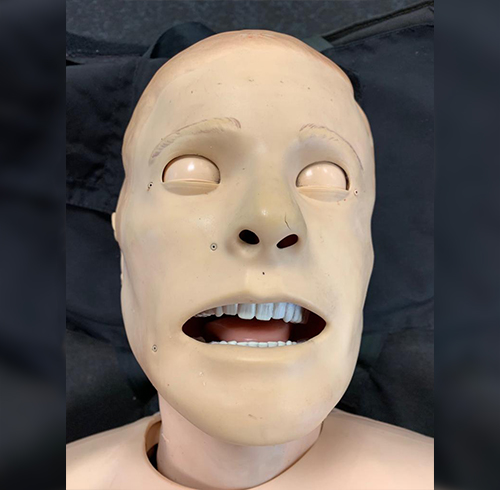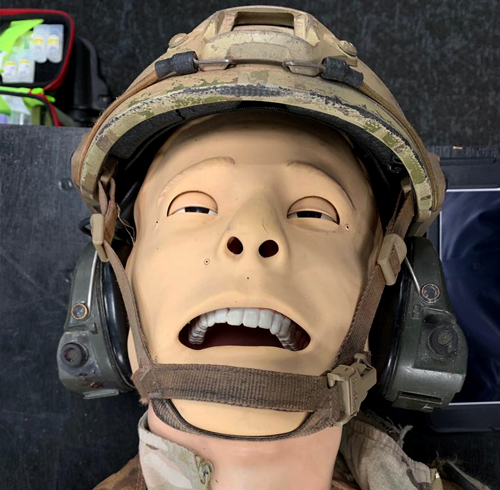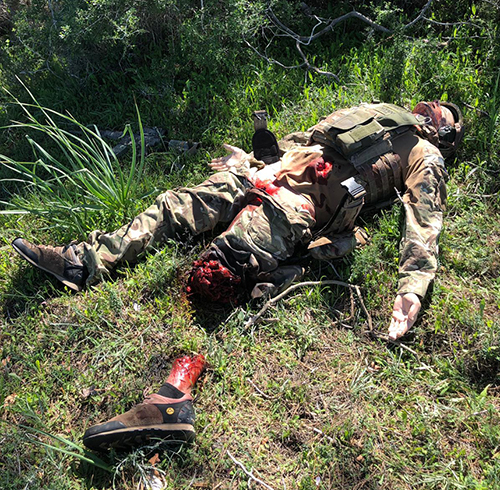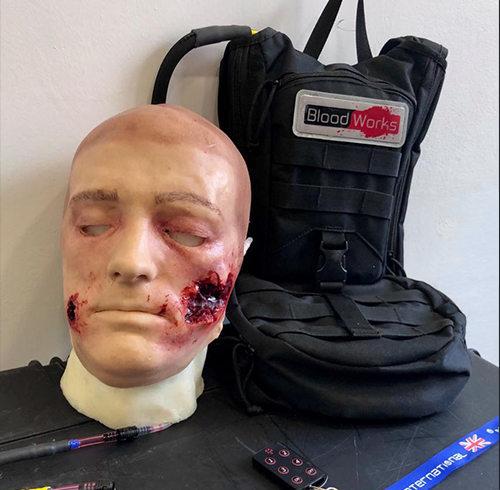Medical Simulation Training Services – What is medical simulation training?
With the increased demand of providing managed services we are continuously innovating to keep training relevant and …. When presented with the challenge of creating a complex injury and gunshot wound to face, we firstly need to understand why we are being asked to re-create it. The answer you may ponder is obvious right? People get shot in the face all the time. Wrong, not in this country they do not. So why the demand for this level of training? When delivering managed services, particularly medical simulation, we are providing professionally trained individuals with experiences of these kinds of trauma which they could expect to see on operations. One of the key services we provide is one of two high fidelity mannequins called SimMan 3G Trauma.

Now as much as you might think SimMan does not look like a real human, you could in fact say he looks a life size plastic robot, there is a very valid reason for that. SimMan is manufactured by a company called Laerdal and the companies roots are firmly planted in the history books as wooden toy makers, whom were pioneering in soft plastics in the early 1950’s. Chitty Chitty Bang Bang springs to mind and Benny Hill as the masterful toymaker! By the early 1960’s a life-like Resusci Anne was created. Resusci Anne is now know the world over, as a training manikin for mouth-to-mouth resuscitation, as is Laerdal and there life-saving products. So, for those of you who are unfamiliar with SimMan 3G Trauma, SimMan resides in hundreds of comfortable NHS Hospital beds dotted up and down the country, whereby hospitals whom have a medical simulation suite or centre will, undoubtedly have a fairly healthy looking SimMan 3G Trauma.

We tend to do things differently at Nautilus. The plastic looking roots of this impressive capability do not entirely work for how we are using these SimMan machines, that is why we think up innovative ways to create the desired effect. Our SimMan products do not sit in comfortable hospital beds. When they are literally recharging they lay in the prone position, on rack mounted shelving amongst there lesser able comrades – SimBodies. Poised like coiled springs in readiness for the next training serials. Invariably SimMan will either be dressed in friendly forces uniform, wearing all of the latest PPE. Chest plate carriers, helmet, weaponry – fully equipped. You could find SimMan dangling from a tree after a harsh landing from parachuting, staged of course, we don’t actually thrown SimMan out of the back of an aircraft. SimMan could be getting winched onto a helicopter, or casualty evacuated from a ship by a high speed craft. What is unique about this is two things. The mechanism of injury is always different, as is the clothing and PPE worn. The handler of SimMan is always present who strictly controls the signs and symptoms, that the medically trained professionals must deal with. Everywhere SimMan goes the handler goes.

Imagine this then. Having been briefed by the UK MOD Exercise Controllers, they would like a friendly forces casualty with GSW to the head, our role would be to create the visual effect and produce accurate signs and symptoms of this mechanism of injury through SimMan. This would test any military medics ability to make the right lifesaving decisions including early intervention at the point of injury. If we did not have the GSW face mask made the military medic would be faced with the very familiar face of a plastic looking SimMan. The GSW face mask, coupled to either the internal pump of SimMan to push simulated blood through the entry and exit of the face or the BloodWorks pump, creates the very realistic illusion that you are treating a human. Add the background noise of gunfire and the pre-recorded noises or Bluetooth talk through capability of a SimMan ,who is struggling with blood loss and a compromised airway and you have the recipe for a perfect storm. If SimMan survives and initial interventions are correctly performed, SimMan hopefully makes it onto the back of a CH47 Chinook helicopter, where a Medical Emergency Response Team will take over. At this stage SimMan will more than likely be intubated and other procedures performed in flight. Only upon landing at the emergency helicopter landing zone at a field hospital would the serial end. Testing certainly. Challenging absolutely.

If mannequins earned medals ours would have a chest full. So would the professionally trained medic Chris our handler. If you would like to find out more about our delivery of medical simulation services please get in touch.
